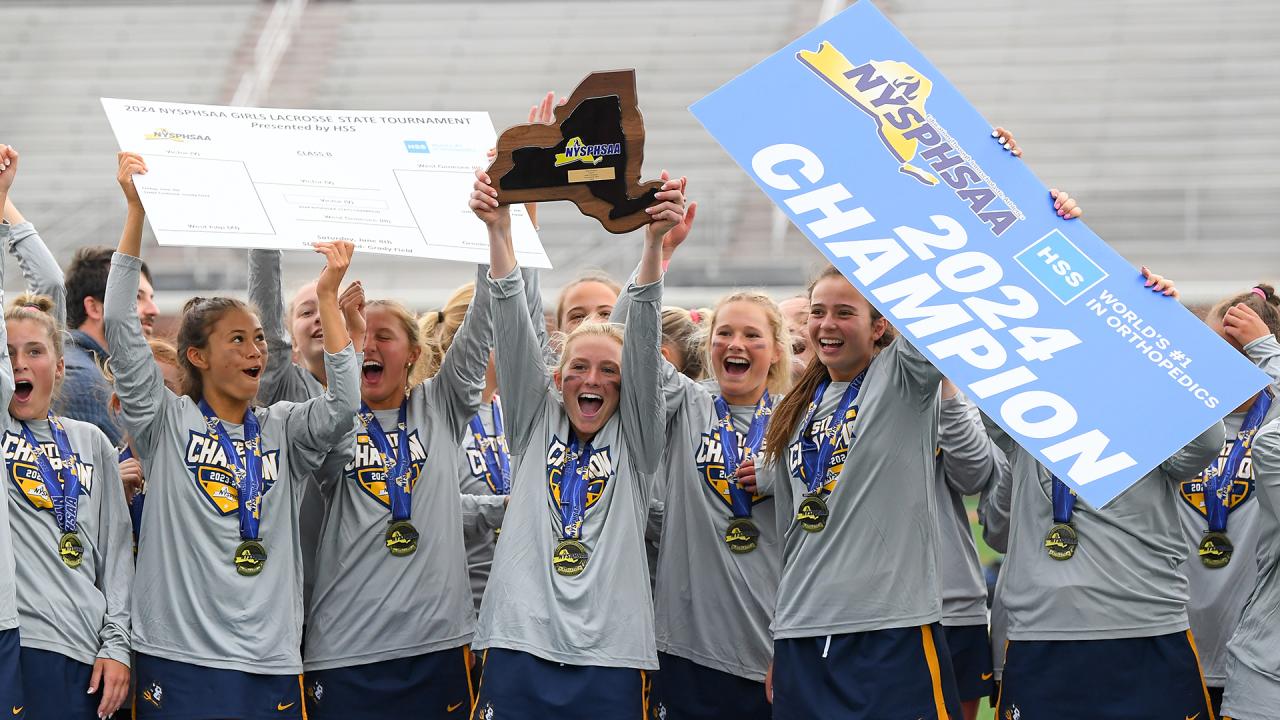The Wappingers girls’ lacrosse team made history last spring as the first Dutchess County, N.Y., team to reach the Section 1 championship.
The Titans came close to more history when they lost 7-6 to Suffern in the title game. Their defeat was sealed after Suffern chose to hold the ball for over 10 minutes to end the game after losing their top player to two yellow cards.
“Ultimately, what they did was within the rules of the game,” Wappingers coach Sean Rowan said. “And to be honest, we had done it to opponents as well. So, it was just always part of the game when you had a lead — you slow it down and limit possessions.”
That scenario won’t happen to the same degree next season after the National Federation of State High School Associations (NFHS) approved a New York State Public High School Athletic Association (NYSPHSAA) request to experiment with a shot clock for boys’ and girls’ lacrosse in 2025.
“This is an experiment. We are analyzing data. We are looking at the effectiveness of the shot clock to make sure it’s going to add and benefit the game rather than be a detriment,” Dr. Robert Zayas, executive director of NYSPHSAA said. “One of the things that we’re most excited about is to give our student-athletes the opportunity to really lead the way nationally for the use of the possession shot clock.”
Zayas says that every section of New York will use the shot clock. New York is the first sanctioned state playing under NFHS rules to adopt the shot clock for public high school lacrosse. New York was also among the first eight states to adopt a shot clock for basketball when it did so in 1987-88.
NCAA women’s lacrosse introduced a 90-second shot clock in 2017. NCAA men’s lacrosse followed in 2019 when it put an 80-second shot clock in place (the possessing team must cross midfield within 20 seconds). The college men added a 60-second reset in 2021-22 if the offensive team regains possession after a shot.
The Premier Lacrosse League has a 52-second shot clock that last year was reduced to 32 seconds on faceoff wins and on offensive resets after the attack retains possession. The National Lacrosse League has a 30-second shot clock.
In June, World Lacrosse proposed an 80-second clock for both men and women. Final details are being sorted out, but if it passes, it will go into effect January 2026 for men and January 2027 for women.
“It really legitimizes the sport at the high school level,” Highland Park (Texas) boys’ coach Mike Pressler said. “This is something these guys are going to play with in college anyway and can start it up now.”
Pressler has coached at every level. Currently the New York Atlas coach in the PLL, the former Duke and Bryant head coach has spent the last two springs coaching Highland Park.
“The speed of the game, the speed of practice, the speed of coaching, it changes everything,” Pressler said. “It’s been great in my two years here in Texas being a high school coach. I couldn’t imagine not playing with it.”
Texas, which is working to get lacrosse sanctioned statewide, uses slightly modified NCAA rules. The Lone Star State has been playing with a shot clock on the boys’ side for three seasons.
“We’ve had no glitches,” said Troy Walker, commissioner of the Texas High School Lacrosse League. “As far as the league is concerned, there have been no protests on shot clock scoring. We’ve had no issues whatsoever.”
Texas’ governing body meets in September each year to vote on any modified or changed NCAA rules that they want to adopt. Texas uses the 80-second shot clock used by NCAA men’s lacrosse but without the 60-second reset.
“Typically, we adopt all the rules, unless it’s just going to be a nightmare,” Walker said. “Like video replay would be an absolute nightmare for us. So, we don’t do that.”
Texas chose not to use the 60-second reset because teams often have parent volunteers operating shot clocks and want to keep it as simple as possible. Last spring, for the first time, to eliminate any potential bias, they used state officials to run the shot clock in all playoff games. The Texas Girls High School Lacrosse League (TGHSLL) has not adopted the shot clock but expects to explore its addition for 2026.
“We’re going to use it at the sixes level, but my traditional lacrosse teams want it to come in, too,” Kristi Cancelmo, president of the TGHSLL, said. “I think everybody is expecting it to come in, and I think they want it. We kind of thought it would happen last year.”
Private high schools have employed the shot clock already in several areas of the country. The girls’ Interscholastic Athletic Association of Maryland (IAAM) adopted it in 2022 in its A and B Conferences, while the boys’ Maryland Interscholastic Athletic Association (MIAA) introduced the shot clock in 2019.
“It makes the game better in every aspect,” Bryan Kelly, Calvert Hall (Md.) head coach, said. “It really allows the team that’s playing the best to win. You can’t stall, you can’t slow the game down, you have a certain timeframe to make something happen. And if you don’t, the ball’s going the other way, and it could be two minutes left in the game and you’re down by two, you still have a chance to win.”
Kelly won’t play games that don’t use the shot clock anymore because the game changes so drastically for his players. It’s like going back to a flip phone after having a smartphone.
“If you’re not running a shot clock, you’re not preparing these kids for college,” Kelly said. “So, they go in and they’re at a massive disadvantage, in my opinion.”
The Philadelphia-area Inter-Ac girls’ league played with a shot clock in 2024 for the first time. The Inter-Ac boys adopted one in 2020, a year after the NCAA. The Washington, D.C., area Interstate Athletic Conference boys started in 2019. The New England West 1 teams added shot clock in 2022.
“I think it was only a matter of time, just with how much women’s lacrosse has developed,” Rowan said. “Ultimately, I think that it’s going to take probably a year for people to get used to it. But like anything else, as rules change, you’ve got to adjust and adapt and kind of embrace all the changes.”



























































